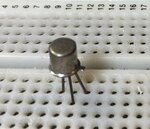schmitt trigger
Advanced Member level 5

It was cold and raining outside, a miserable Sunday afternoon. I had just finished a book, and did not want to binge-watch another Netflix series. Bored to death, I headed to my lab to figure out something, anything, to do.
Rummaging thru my parts bin, I noticed some 2N2646 unijunction transistors. When was the last time I actually built something employing a metal-case transistor? Eons ago. So I decided that this was it.
I quickly downloaded the 2N2646 datasheet, and quickly breadboarded a circuit, and in no time I had a oscillator running consisting of only 3 resistors, 1 capacitor and a single transistor.
Could this simple circuit be enhanced? The Base1 pulse is kind of wimpy, and the emitter waveform is the classic non linear RC-charging ramp.
The first thing is to replace the capacitor charging resistor with a CC source. There are dozens of CC schematics, but in the spirit of discrete transistors, it was replaced with a J175 P-chan JFET found in my parts bin. This transistor has as very healthy IDSS of up to -60 mA. Therefore it has to be throttled down with a source resistor. If a trimpot is inserted in series with the resistor, the current and therefore the frequency can be adjusted.
To amplify the output pulse to a rail to rail level, the B1 pulse was applied to the gate of an 2N7000 Mosfet, also from the parts bin.
Now that I have a nice looking pulse, what should I do with it? Drive a transistor bi-stable multivibrator, of course. Classic circuitry, I initially simulated in LTSpice to find workable values. Once that I became satisfied, I breadboarded the circuit, and connected it to the pulse.
The final schematic is attached, and the results are shown in the waveforms image. Amazing that with such simple circuitry, using only discrete semiconductors, many things can be achieved.
BONUS POINTS: And it was done with the four main transistor families: UJT, JFET, MOSFET and BJT. Hurray!
By now, my wife is calling me. Supper is ready
Rummaging thru my parts bin, I noticed some 2N2646 unijunction transistors. When was the last time I actually built something employing a metal-case transistor? Eons ago. So I decided that this was it.
I quickly downloaded the 2N2646 datasheet, and quickly breadboarded a circuit, and in no time I had a oscillator running consisting of only 3 resistors, 1 capacitor and a single transistor.
Could this simple circuit be enhanced? The Base1 pulse is kind of wimpy, and the emitter waveform is the classic non linear RC-charging ramp.
The first thing is to replace the capacitor charging resistor with a CC source. There are dozens of CC schematics, but in the spirit of discrete transistors, it was replaced with a J175 P-chan JFET found in my parts bin. This transistor has as very healthy IDSS of up to -60 mA. Therefore it has to be throttled down with a source resistor. If a trimpot is inserted in series with the resistor, the current and therefore the frequency can be adjusted.
To amplify the output pulse to a rail to rail level, the B1 pulse was applied to the gate of an 2N7000 Mosfet, also from the parts bin.
Now that I have a nice looking pulse, what should I do with it? Drive a transistor bi-stable multivibrator, of course. Classic circuitry, I initially simulated in LTSpice to find workable values. Once that I became satisfied, I breadboarded the circuit, and connected it to the pulse.
The final schematic is attached, and the results are shown in the waveforms image. Amazing that with such simple circuitry, using only discrete semiconductors, many things can be achieved.
BONUS POINTS: And it was done with the four main transistor families: UJT, JFET, MOSFET and BJT. Hurray!
By now, my wife is calling me. Supper is ready



